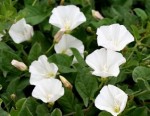 This trailing or climbing perennial is a native of Eurasia introduced into North America by 1739 and now found in all states except Alaska. It is classified as a noxious weed in many states and is on the list of the world’s ten worst weeds. Field bindweed prefers full sun with medium to dry conditions, and does well in both fertile and infertile soil. It likes disturbed areas and invades lawns, gardens, croplands, and waste areas. Field bindweed can entwine itself in other plants causing serious harm and reducing the productivity of cropland.
This trailing or climbing perennial is a native of Eurasia introduced into North America by 1739 and now found in all states except Alaska. It is classified as a noxious weed in many states and is on the list of the world’s ten worst weeds. Field bindweed prefers full sun with medium to dry conditions, and does well in both fertile and infertile soil. It likes disturbed areas and invades lawns, gardens, croplands, and waste areas. Field bindweed can entwine itself in other plants causing serious harm and reducing the productivity of cropland.
 Description:
Description:  The first leaves (cotyledons) of seedlings are square with a notch on one side while the true leaves are arrow-shaped and grow up to 2 inches long. Slender petioles attached the alternate leaves to the twining stems that grow 2 to 6 feet long. The white to pink flowers are trumpet shaped and up to 1½ inches across. Flowering can begin in late spring continue until fall with each flower opening in the morning, losing by afternoon, and lasting only one day. Round seed capsules follow and contain 4 seeds that can remain viable in the soil for up to 60 years. A single plant can produce over 500 seeds. The root system, however, is the real culprit in regard to the spread and persistence of the plant. It consists of deep vertical roots that can go down 20 feet into the soil, and shallow horizontal rhizomes that can spread 10 feet from the plant in all directions. Most of this root mass can produce buds that produce new plants.
The first leaves (cotyledons) of seedlings are square with a notch on one side while the true leaves are arrow-shaped and grow up to 2 inches long. Slender petioles attached the alternate leaves to the twining stems that grow 2 to 6 feet long. The white to pink flowers are trumpet shaped and up to 1½ inches across. Flowering can begin in late spring continue until fall with each flower opening in the morning, losing by afternoon, and lasting only one day. Round seed capsules follow and contain 4 seeds that can remain viable in the soil for up to 60 years. A single plant can produce over 500 seeds. The root system, however, is the real culprit in regard to the spread and persistence of the plant. It consists of deep vertical roots that can go down 20 feet into the soil, and shallow horizontal rhizomes that can spread 10 feet from the plant in all directions. Most of this root mass can produce buds that produce new plants.

 Control: The sprouting ability of the root system combined with the longevity of the seeds make field bindweed a very difficult plant to eradicate. Count on fighting it for a long time. The first line of defense is to remove seedlings as they appear. They have distinctive square notched cotyledons that are easy to recognize, followed by arrow–shaped leaves that are equally easy to identify. Once the plants are established they must be dug as deeply as possible with care taken to break as few roots as possible because a piece of root ½ inch long can produce a new plant. Repeat the digging as new plants emerge. Mowing can effective in controlling large invasions of bindweed. Mow when the plants have grown to flowering size so they use up food stored in their roots. Repeat when the new plants emerge. This procedure may take several years but eventually the bindweed will be so weakened that it will not return. Mulching with landscape cloth, cardboard, or black plastic is effective if no light reaches the soil; any hole letting in light will be the escape hatch for the bindweed. Mowing also eliminates or reduces the number of seeds that will enter the soil.
Control: The sprouting ability of the root system combined with the longevity of the seeds make field bindweed a very difficult plant to eradicate. Count on fighting it for a long time. The first line of defense is to remove seedlings as they appear. They have distinctive square notched cotyledons that are easy to recognize, followed by arrow–shaped leaves that are equally easy to identify. Once the plants are established they must be dug as deeply as possible with care taken to break as few roots as possible because a piece of root ½ inch long can produce a new plant. Repeat the digging as new plants emerge. Mowing can effective in controlling large invasions of bindweed. Mow when the plants have grown to flowering size so they use up food stored in their roots. Repeat when the new plants emerge. This procedure may take several years but eventually the bindweed will be so weakened that it will not return. Mulching with landscape cloth, cardboard, or black plastic is effective if no light reaches the soil; any hole letting in light will be the escape hatch for the bindweed. Mowing also eliminates or reduces the number of seeds that will enter the soil.
Chemicals are not a quick way of dealing with bindweed. If they must be used, apply herbicides such as dicamba, 2,4-D, or glyphosate when the plants are growing vigorously and repeat as necessary. Several applications will probably be needed with follow-ups in subsequent years.